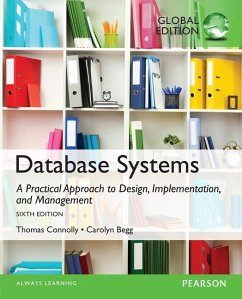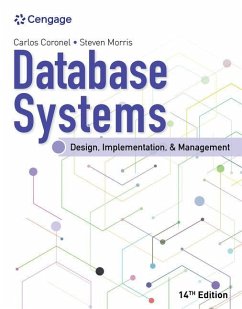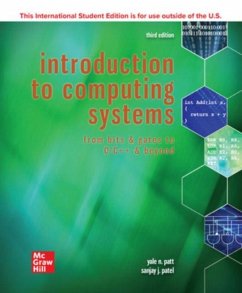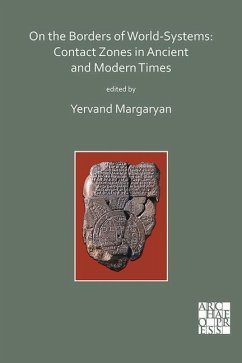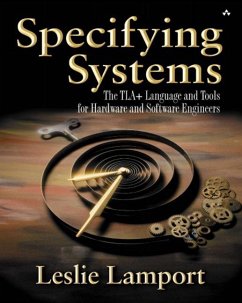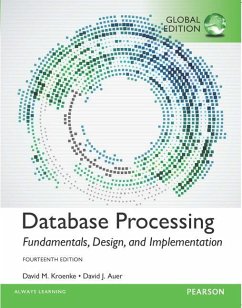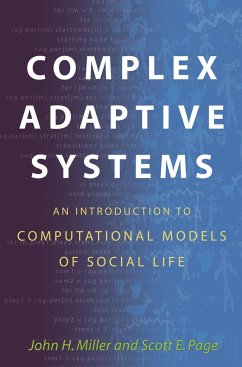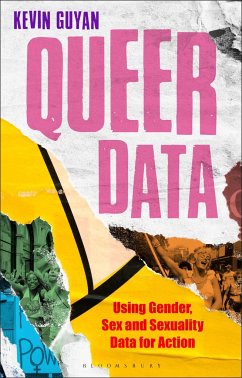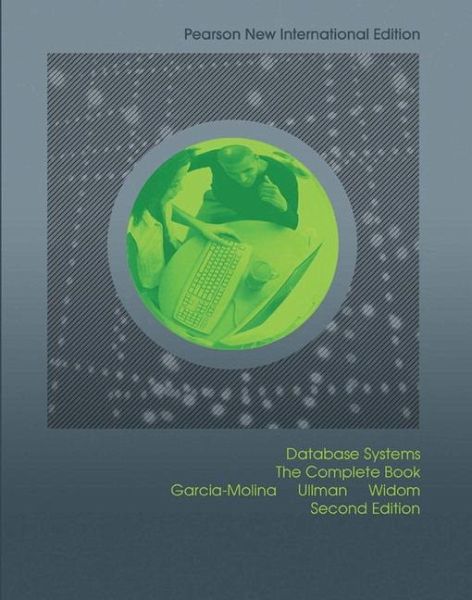
Database Systems: The Complete Book
Pearson New International Edition

PAYBACK Punkte
60 °P sammeln!
For Database Systems and Database Design and Application courses offered at the junior, senior and graduate levels in Computer Science departments.
Written by well-known computer scientists, this introduction to database systems offers a comprehensive approach, focusing on database design, database use, and implementation of database applications and database management systems.
The first half of the book provides in-depth coverage of databases from the point of view of the database designer, user, and application programmer. It covers the latest database standards SQL:1999, SQL/PSM, SQL/CLI, JDBC, ODL, and XML, with broader coverage of SQL than most other texts. The second half of the book provides in-depth coverage of databases from the point of view of the DBMS implementor. It focuses on storage structures, query processing, and transaction management. The book covers the main techniques in these areas with broader coverage of query optimization than most other texts, along with advanced topics including multidimensional and bitmap indexes, distributed transactions, and information integration techniques.
Resources:
Open access Author Website ¿http://infolab.stanford.edu/~ullman/dscb.html ¿includes Power Point slides, teaching notes, assignments, projects, Oracle Programming Guidelines, and solutions to selected exercises.
Instructor only Pearson Resources: Complete Solutions Manual (click on the Resources tab above to view downloadable files)
Features + Benefits
Many real-world examples.
Offers a readable and engaging presentation.
Extensive treatment of database modeling–Includes detailed and separate explanations of how to use E/R and ODL to design databases.
Teaches about this important first step of the planning process.
Excellent, up-to-date and detailed coverage of SQL–Includes coverage of object-relational systems and many aspects of the new SQL:1999 standard.
Provides a more extensive treatment of query processing than other books on the market.
Discussion of the technologies used to connect database programming with C or Java code–Includes discussions of SQL/PSM, SQL/CLI, and JDBC.
Gives students practical advice on integrating state-of-the-art technologies with databases.
Coverage of advanced issues important to database designers and users.
Includes discussions of views, integrity constraints, assertions, triggers, transactions, authorization, and recursion in SQL:1999.
Discussions of how to successfully plan a database application before building it.
Reflects how these plans are developed in the real world.
Coverage of topics such as designing storage structures and implementing a variety of indexing schemes.
Shows students how to build efficient database management systems.
Extensive coverage of query processing and optimization.
Shows students how to fine tune database systems to improve performance.
Comprehensive coverage of transaction processing mechanisms for concurrency control and recovery, including distributed and long-duration transactions.
Shows how to design complex database systems that can handle real-world business applications.
Coverage of information integration, including data warehousing, mediation, OLAP, data-cube systems, and data mining.
Exposes readers to cutting edge technology used in business applications.
Extensive exercises–In almost every section.
Provides students with the opportunity to practice and apply the concepts they've learned in each chapter.
Please note that GOAL/Gradiance is no longer available with this book.
TABLE OF CONTENTS
1 The Worlds of Database Systems
1.1 The Evolution of Database Systems
1.1.1 Early Database Management Systems
1.1.2 Relational Database Systems
1.1.3 Smaller and Smaller Systems
1.1.4 Bigger and Bigger Systems
1.1.5 Information Integration
1.2 Overview of a Database Management System
1.2.1 Data-Definition Language Commands
1.2.2 Overview of Query Processing
1.2.3 Storage and Buffer Management
1.2.4 Transaction Processing
1.2.5 The Query Processor
1.3 Outline of Database-System Studies
1.4 References for Chapter 1
PART I: Relational Database Modeling
2 The Relational Model of Data
2.1 An Overview of Data Models
2.1.1 What is a Data Model?
2.1.2 Important Data Models
2.1.3 The Relational Model in Brief
2.1.4 The Semistructured Model in Brief
2.1.5 Other Data Models
2.1.6 Comparison of Modeling Approaches
2.2 Basics of the Relational Model
2.2.1 Attributes
2.2.2 Schemas
2.2.3 Tuples
2.2.4 Domains
2.2.5 Equivalent Representations of a Relation
2.2.6 Relation Instances
2.2.7 Keys of Relations
2.2.8 An Example Database Schema
2.2.9 Exercises for Section 2.2
2.3 Defining a Relation Schema in SQL
2.3.1 Relations in SQL
2.3.2 Data Types
2.3.3 Simple Table Declarations
2.3.4 Modifying Relation Schemas
2.3.5 Default Values
2.3.6 Declaring Keys
2.3.7 Exercises for Section 2.3
2.4 An Algebraic Query Language
2.4.1 Why Do We Need a Special Query Language?
2.4.2 What is an Algebra?
2.4.3 Overview of Relational Algebra
2.4.4 Set Operations on Relations
2.4.5 Projection
2.4.6 Selection
2.4.7 Cartesian Product
2.4.8 Natural Joins
2.4.9 Theta-Joins
2.4.10 Combining Operations to Form Queries
2.4.11 Naming and Renaming
2.4.12 Relationships Among Operations
2.4.13 A Linear Notation for Algebraic Expressions
2.4.14 Exercises for Section 2.4
2.5 Constraints on Relations
2.5.1 Relational Algebra as a Constraint Language
2.5.2 Referential Integrity Constraints
2.5.3 Key Constraints
2.5.4 Additional Constraint Examples
2.5.5 Exercises for Section 2.5
2.6 Summary of Chapter 2
2.7 References for Chapter 2
3 Design Theory for Relational Databases
3.1 Functional Dependencies
3.1.1 Definition of Functional Dependency
3.1.2 Keys of Relations
3.1.3 Superkeys
3.1.4 Exercises for Section 3.1
3.2 Rules About Functional Dependencies
3.2.1 Reasoning About Functional Dependencies
3.2.2 The Splitting/Combining Rule
3.2.3 Trivial Functional Dependencies
3.2.4 Computing the Closure of Attributes
3.2.5 Why the Closure Algorithm Works
3.2.6 The Transitive Rule
3.2.7 Closing Sets of Functional Dependencies
3.2.8 Projecting Functional Dependencies
3.2.9 Exercises for Section 3.2
3.3 Design of Relational Database Schemas
3.3.1 Anomalies
3.3.2 Decomposing Relations
3.3.3 Boyce-Codd Normal Form
3.3.4 Decomposition into BCNF
3.3.5 Exercises for Section 3.3
3.4 Decomposition: The Good, Bad, and Ugly
3.4.1 Recovering Information from a Decomposition
3.4.2 The Chase Test for Lossless Join
3.4.3 Why the Chase Works
3.4.4 Dependency Preservation
3.4.5 Exercises for Section 3.4
3.5 Third Normal Form
3.5.1 Definition of Third Normal Form
3.5.2 The Synthesis Algorithm for 3NF Schemas
3.5.3 Why the 3NF Synthesis Algorithm Works
3.5.4 Exercises for Section 3.5
3.6 Multivalued Dependencies
3.6.1 Attribute Independence and Its Consequent Redundancy
3.6.2 Definition of Multivalued Dependencies
3.6.3 Reasoning About Multivalued Dependencies
3.6.4 Fourth Normal Form
3.6.5 Decomposition into Fourth Normal Form
3.6.6 Relationships Among Normal Forms
3.6.7 Exercises for Section 3.6
3.7 An Algorithm for Discovering MVD's
3.7.1 The Closure and the Chase
3.7.2 Extending the Chase to MVD's
3.7.3 Why the Chase Works for MVD's
3.7.4 Projecting MVD's
3.7.5 Exercises for Section 3.7
3.8 Summary of Chapter 3
3.9 References for Chapter 3
4 High-Level Database Models
4.1 The Entity/Relationship Model
4.1.1 Entity Sets
4.1.2 Attributes
4.1.3 Relationships
4.1.4 Entity-Relationship Diagrams
4.1.5 Instances of an E/R Diagram
4.1.6 Multiplicity of Binary E/R Relationships
4.1.7 Multiway Relationships
4.1.8 Roles in Relationships
4.1.9 Attributes on Relationships
4.1.10 Converting Multiway Relationships to Binary
4.1.11 Subclasses in the E/R Model
4.1.12 Exercises for Section 4.1
4.2 Design Principles
4.2.1 Faithfulness
4.2.2 Avoiding Redundancy
4.2.3 Simplicity Counts
4.2.4 Choosing the Right Relationships
4.2.5 Picking the Right Kind of Element
4.2.6 Exercises for Section 4.2
4.3 Constraints in the E/R Model
4.3.1 Keys in the E/R Model
4.3.2 Representing Keys in the E/R Model
4.3.3 Referential Integrity
4.3.4 Degree Constraints
4.3.5 Exercises for Section 4.3
4.4 Weak Entity Sets
4.4.1 Causes of Weak Entity Sets
4.4.2 Requirements for Weak Entity Sets
4.4.3 Weak Entity Set Notation
4.4.4 Exercises for Section 4.4
4.5 From E/R Diagrams to Relational Designs
4.5.1 From Entity Sets to Relations
4.5.2 From E/R Relationships to Relations
4.5.3 Combining Relations
4.5.4 Handling Weak Entity Sets
4.5.5 Exercises for Section 4.5
4.6 Converting Subclass Structures to Relations
4.6.1 E/R-Style Conversion
4.6.2 An Object-Oriented Approach
Written by well-known computer scientists, this introduction to database systems offers a comprehensive approach, focusing on database design, database use, and implementation of database applications and database management systems.
The first half of the book provides in-depth coverage of databases from the point of view of the database designer, user, and application programmer. It covers the latest database standards SQL:1999, SQL/PSM, SQL/CLI, JDBC, ODL, and XML, with broader coverage of SQL than most other texts. The second half of the book provides in-depth coverage of databases from the point of view of the DBMS implementor. It focuses on storage structures, query processing, and transaction management. The book covers the main techniques in these areas with broader coverage of query optimization than most other texts, along with advanced topics including multidimensional and bitmap indexes, distributed transactions, and information integration techniques.
Resources:
Open access Author Website ¿http://infolab.stanford.edu/~ullman/dscb.html ¿includes Power Point slides, teaching notes, assignments, projects, Oracle Programming Guidelines, and solutions to selected exercises.
Instructor only Pearson Resources: Complete Solutions Manual (click on the Resources tab above to view downloadable files)
Features + Benefits
Many real-world examples.
Offers a readable and engaging presentation.
Extensive treatment of database modeling–Includes detailed and separate explanations of how to use E/R and ODL to design databases.
Teaches about this important first step of the planning process.
Excellent, up-to-date and detailed coverage of SQL–Includes coverage of object-relational systems and many aspects of the new SQL:1999 standard.
Provides a more extensive treatment of query processing than other books on the market.
Discussion of the technologies used to connect database programming with C or Java code–Includes discussions of SQL/PSM, SQL/CLI, and JDBC.
Gives students practical advice on integrating state-of-the-art technologies with databases.
Coverage of advanced issues important to database designers and users.
Includes discussions of views, integrity constraints, assertions, triggers, transactions, authorization, and recursion in SQL:1999.
Discussions of how to successfully plan a database application before building it.
Reflects how these plans are developed in the real world.
Coverage of topics such as designing storage structures and implementing a variety of indexing schemes.
Shows students how to build efficient database management systems.
Extensive coverage of query processing and optimization.
Shows students how to fine tune database systems to improve performance.
Comprehensive coverage of transaction processing mechanisms for concurrency control and recovery, including distributed and long-duration transactions.
Shows how to design complex database systems that can handle real-world business applications.
Coverage of information integration, including data warehousing, mediation, OLAP, data-cube systems, and data mining.
Exposes readers to cutting edge technology used in business applications.
Extensive exercises–In almost every section.
Provides students with the opportunity to practice and apply the concepts they've learned in each chapter.
Please note that GOAL/Gradiance is no longer available with this book.
TABLE OF CONTENTS
1 The Worlds of Database Systems
1.1 The Evolution of Database Systems
1.1.1 Early Database Management Systems
1.1.2 Relational Database Systems
1.1.3 Smaller and Smaller Systems
1.1.4 Bigger and Bigger Systems
1.1.5 Information Integration
1.2 Overview of a Database Management System
1.2.1 Data-Definition Language Commands
1.2.2 Overview of Query Processing
1.2.3 Storage and Buffer Management
1.2.4 Transaction Processing
1.2.5 The Query Processor
1.3 Outline of Database-System Studies
1.4 References for Chapter 1
PART I: Relational Database Modeling
2 The Relational Model of Data
2.1 An Overview of Data Models
2.1.1 What is a Data Model?
2.1.2 Important Data Models
2.1.3 The Relational Model in Brief
2.1.4 The Semistructured Model in Brief
2.1.5 Other Data Models
2.1.6 Comparison of Modeling Approaches
2.2 Basics of the Relational Model
2.2.1 Attributes
2.2.2 Schemas
2.2.3 Tuples
2.2.4 Domains
2.2.5 Equivalent Representations of a Relation
2.2.6 Relation Instances
2.2.7 Keys of Relations
2.2.8 An Example Database Schema
2.2.9 Exercises for Section 2.2
2.3 Defining a Relation Schema in SQL
2.3.1 Relations in SQL
2.3.2 Data Types
2.3.3 Simple Table Declarations
2.3.4 Modifying Relation Schemas
2.3.5 Default Values
2.3.6 Declaring Keys
2.3.7 Exercises for Section 2.3
2.4 An Algebraic Query Language
2.4.1 Why Do We Need a Special Query Language?
2.4.2 What is an Algebra?
2.4.3 Overview of Relational Algebra
2.4.4 Set Operations on Relations
2.4.5 Projection
2.4.6 Selection
2.4.7 Cartesian Product
2.4.8 Natural Joins
2.4.9 Theta-Joins
2.4.10 Combining Operations to Form Queries
2.4.11 Naming and Renaming
2.4.12 Relationships Among Operations
2.4.13 A Linear Notation for Algebraic Expressions
2.4.14 Exercises for Section 2.4
2.5 Constraints on Relations
2.5.1 Relational Algebra as a Constraint Language
2.5.2 Referential Integrity Constraints
2.5.3 Key Constraints
2.5.4 Additional Constraint Examples
2.5.5 Exercises for Section 2.5
2.6 Summary of Chapter 2
2.7 References for Chapter 2
3 Design Theory for Relational Databases
3.1 Functional Dependencies
3.1.1 Definition of Functional Dependency
3.1.2 Keys of Relations
3.1.3 Superkeys
3.1.4 Exercises for Section 3.1
3.2 Rules About Functional Dependencies
3.2.1 Reasoning About Functional Dependencies
3.2.2 The Splitting/Combining Rule
3.2.3 Trivial Functional Dependencies
3.2.4 Computing the Closure of Attributes
3.2.5 Why the Closure Algorithm Works
3.2.6 The Transitive Rule
3.2.7 Closing Sets of Functional Dependencies
3.2.8 Projecting Functional Dependencies
3.2.9 Exercises for Section 3.2
3.3 Design of Relational Database Schemas
3.3.1 Anomalies
3.3.2 Decomposing Relations
3.3.3 Boyce-Codd Normal Form
3.3.4 Decomposition into BCNF
3.3.5 Exercises for Section 3.3
3.4 Decomposition: The Good, Bad, and Ugly
3.4.1 Recovering Information from a Decomposition
3.4.2 The Chase Test for Lossless Join
3.4.3 Why the Chase Works
3.4.4 Dependency Preservation
3.4.5 Exercises for Section 3.4
3.5 Third Normal Form
3.5.1 Definition of Third Normal Form
3.5.2 The Synthesis Algorithm for 3NF Schemas
3.5.3 Why the 3NF Synthesis Algorithm Works
3.5.4 Exercises for Section 3.5
3.6 Multivalued Dependencies
3.6.1 Attribute Independence and Its Consequent Redundancy
3.6.2 Definition of Multivalued Dependencies
3.6.3 Reasoning About Multivalued Dependencies
3.6.4 Fourth Normal Form
3.6.5 Decomposition into Fourth Normal Form
3.6.6 Relationships Among Normal Forms
3.6.7 Exercises for Section 3.6
3.7 An Algorithm for Discovering MVD's
3.7.1 The Closure and the Chase
3.7.2 Extending the Chase to MVD's
3.7.3 Why the Chase Works for MVD's
3.7.4 Projecting MVD's
3.7.5 Exercises for Section 3.7
3.8 Summary of Chapter 3
3.9 References for Chapter 3
4 High-Level Database Models
4.1 The Entity/Relationship Model
4.1.1 Entity Sets
4.1.2 Attributes
4.1.3 Relationships
4.1.4 Entity-Relationship Diagrams
4.1.5 Instances of an E/R Diagram
4.1.6 Multiplicity of Binary E/R Relationships
4.1.7 Multiway Relationships
4.1.8 Roles in Relationships
4.1.9 Attributes on Relationships
4.1.10 Converting Multiway Relationships to Binary
4.1.11 Subclasses in the E/R Model
4.1.12 Exercises for Section 4.1
4.2 Design Principles
4.2.1 Faithfulness
4.2.2 Avoiding Redundancy
4.2.3 Simplicity Counts
4.2.4 Choosing the Right Relationships
4.2.5 Picking the Right Kind of Element
4.2.6 Exercises for Section 4.2
4.3 Constraints in the E/R Model
4.3.1 Keys in the E/R Model
4.3.2 Representing Keys in the E/R Model
4.3.3 Referential Integrity
4.3.4 Degree Constraints
4.3.5 Exercises for Section 4.3
4.4 Weak Entity Sets
4.4.1 Causes of Weak Entity Sets
4.4.2 Requirements for Weak Entity Sets
4.4.3 Weak Entity Set Notation
4.4.4 Exercises for Section 4.4
4.5 From E/R Diagrams to Relational Designs
4.5.1 From Entity Sets to Relations
4.5.2 From E/R Relationships to Relations
4.5.3 Combining Relations
4.5.4 Handling Weak Entity Sets
4.5.5 Exercises for Section 4.5
4.6 Converting Subclass Structures to Relations
4.6.1 E/R-Style Conversion
4.6.2 An Object-Oriented Approach
For Database Systems and Database Design and Application courses offered at the junior, senior and graduate levels in Computer Science departments. Written by well-known computer scientists, this introduction to database systems offers a comprehensive approach, focusing on database design, database use, and implementation of database applications and database management systems. The first half of the book provides in-depth coverage of databases from the point of view of the database designer, user, and application programmer. It covers the latest database standards SQL:1999, SQL/PSM, SQL/CLI, JDBC, ODL, and XML, with broader coverage of SQL than most other texts. The second half of the book provides in-depth coverage of databases from the point of view of the DBMS implementor. It focuses on storage structures, query processing, and transaction management. The book covers the main techniques in these areas with broader coverage of query optimisation than most other texts, along with advanced topics including multidimensional and bitmap indexes, distributed transactions, and information integration techniques.
Dieser Artikel kann nur an eine deutsche Lieferadresse ausgeliefert werden.




